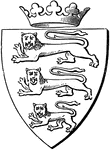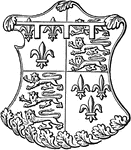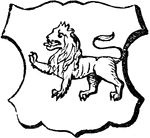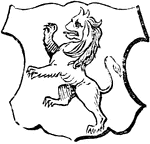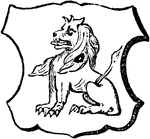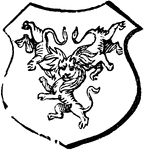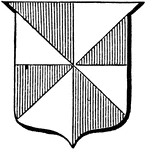
Gyronny
"Gyronny of eight, gules and argent. GYRONNY. In heraldry, dividend into a number of triangular parts…
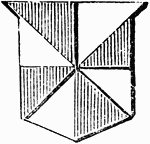
Gyrony Ordinary
"Gyrony of eight pieces, argent and gules. The field is said to be gyrony when it is covered with gyrons."…
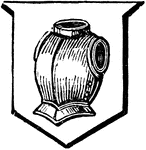
Habergeon
"Argent, an habergeon proper. HABERGEON. A coat of mail: it is also called a corslet and cuirass." -Hall,…

Hand and Bordure
"Argent, a sinister hand couped at the wrist and erected gules, within a bordure azure. BORDURE or BORDER.…
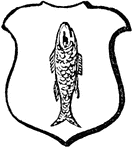
Haurient
"Argent, a salmon proper haurient. HAURIENT. A fish, in a perpendicular direction, with its head upwards."…
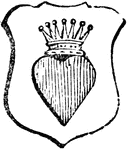
Heart Ensigned
"Argent, a man's heart gules, ensigned with a celestial crown or. ENSIGNED. This word, in heraldic description,…
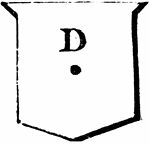
Honour Point
"HONOUR POINT. That part of the shield between the precise middle chief and the fess point. In the annexed…
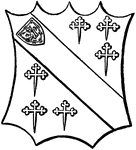
Augmented Shield of Howard
The heraldic shield of the British Howard family, after its augmentation.
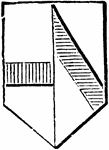
Impaled
"Argent, a fess gules, impaled with argent, a bend azure. IMPALED. Two coats of arms, conjoined paleways,…
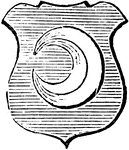
Increscent
"Azure, a moon increscent argent. INCRESCENT. The new moon, with her horns turned towards the dexter…
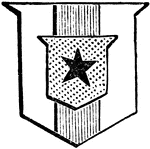
Inescutcheon Ordinary
"Argent, a pale, gules, over all an inescutcheon or, a mullet sable. The inescutcheon is a small escutcheon…
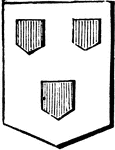
Inescutcheons
"Argent, three inescutcheons gules. INESCUTCHEON. The name given to small escutcheons forming a bearing…
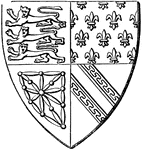
Shield of Queen Isabella
"Quartered shield of arms borne by Isabella, Queen of Edward II."—Aveling, 1891
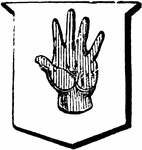
Knight and Baronet of King James I
"KNIGHT AND BARONET. A degree of honour next to a baron, created by King James I. to induce the English…
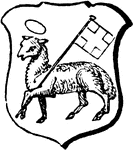
Paschal Lamb
"Argent, a lamb passant, carrying a banner charged with a cross. PASCHAL LAMB, or HOLY LAMB." -Hall,…

Effigy of Henry, First Duke of Lancaster
An effigy of the first Duke of Lancaster in his coat of arms.
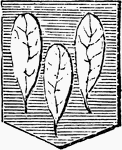
Leaves Slipped
"Azure, three laurel leaves slipped, argent. SLIPPED. Torn from the stock or branch." -Hall, 1862
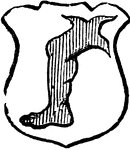
Leg Erased
"Argent, a leg erased at the midst of the thigh gules. ERASED. Signifies any thing torn or plucked off…

Legs Conjoined
"Argent, three legs armed, conjoined at the fess point at the upper extremity of the thigh, flexed in…
Line Angled
A line angled for dividing a field. "Escutcheons that have more than one tincture are divided by lines…
Line Arched
A line arched or enarched for dividing a field. "Escutcheons that have more than one tincture are divided…
Line Bevilled
A line bevilled for dividing a field. "Escutcheons that have more than one tincture are divided by lines…
Line Dancette
A line dancette for dividing a field. "Escutcheons that have more than one tincture are divided by lines…
Line Double Arched
A line double arched for dividing a field. "Escutcheons that have more than one tincture are divided…
Line Dove-Tailed
A line dove-tailed for dividing a field. "Escutcheons that have more than one tincture are divided by…
Line Embattled
A line embattled or crenelle for dividing a field. "Escutcheons that have more than one tincture are…
Line Embattled Grady
A line embattled grady or battled embattled for dividing a field. "Escutcheons that have more than one…
Line Engrailed
A line engrailed for dividing a field. "Escutcheons that have more than one tincture are divided by…
Line Escartelle
A line escartelle for dividing a field. "Escutcheons that have more than one tincture are divided by…
Line Indented
A line indented for dividing a field. "Escutcheons that have more than one tincture are divided by lines…
Line Invected
A line invected for dividing a field. "Escutcheons that have more than one tincture are divided by lines…
Line Nebule
A line nebule for dividing a field. "Escutcheons that have more than one tincture are divided by lines…
Line Nowy
A line nowy or franché for dividing a field. "Escutcheons that have more than one tincture are…
Line Potent
A line potent for dividing a field. "Escutcheons that have more than one tincture are divided by lines…

Line Radient
A line radient for dividing a field. "Escutcheons that have more than one tincture are divided by lines…
Line Urdée
A line urdée for dividing a field. "Escutcheons that have more than one tincture are divided…
Line Wavy
A line wavy or undé for dividing a field. "Escutcheons that have more than one tincture are divided…

Lion Couchant
"Lion couchant. COUCHANT. The French word for lying down with the breast towards the earth, and the…
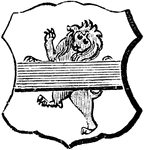
Lion Debruised
"Argent, a lion rampant guardant gules, debruised by a fess azure. DEBRUISED. Any animal that has an…
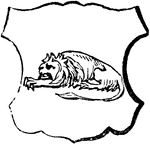
Lion Dormant
"Lion dormant. DORMANT. The French word for sleeping, used to denote the posture of a lion, or any other…
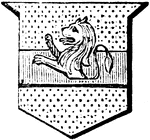
Lion Naissant
"Or, from the midst of a fess, gules, a lion rampant naissant. NAISSANT. A French word signifying coming…

Lion Rampant Double-Headed
"Lion rampant double-headed. RAMPANT. Any beast in a fighting attitude." -Hall, 1862
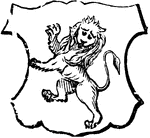
Lion Rampant Gardant
"Lion rampant gardant. RAMPANT. Any beast in a fighting attitude." GARDANT. Facing foward. -Hall, 1862
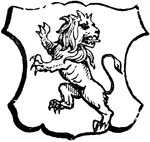
Lion Rampant Regardant
"Lion rampant regardant. RAMPANT. Any beast in a fighting attitude. REGARDANT. An animal looking towards…
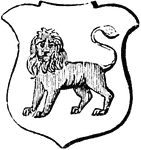
Lion Statant Gardant
"Lion statant gardant. STATANT. An animal standing still with all its legs on the ground." GARDANT.…
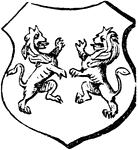
Lioncels Combatant
"Lioncels combatant. LIONCELS. Two or more lions. COMBATANT. A French word for fighting." -Hall, 1862
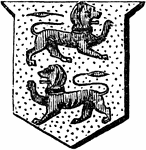
Lions Counter Passant
"Or, two lions passant counter passant gules, the uppermost facing the sinister side of the escutcheon,…

Lozenge
"Or, a lozenge vert. LOZENGE. An angular figure, known as diamond-shaped, to distinguish it from the…
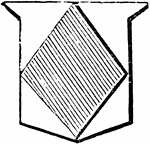
Lozenge Ordinary
"Argent, a lozenge, vert. The lozenge is formed by four equal and parallel lines but not rectangular,…
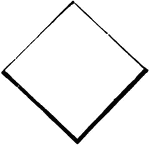
Lozenge Shield
"The escutcheons of maiden ladies and widows are painted on a lozenge-shaped shield." -Hall, 1862
